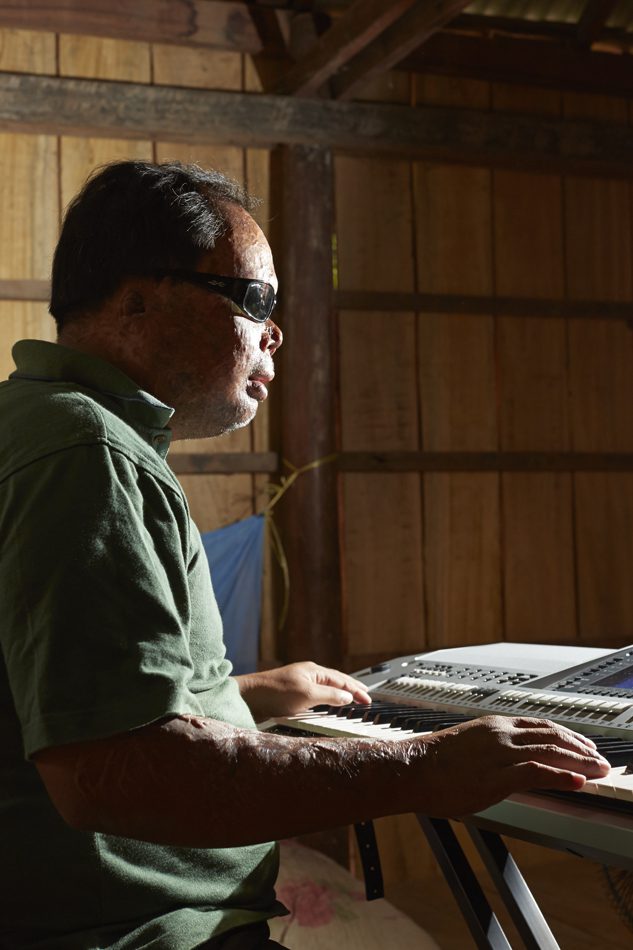She answers the door, her face veiled with a krama. Children play in front of their Phnom Penh house. A massive garbage dump smoulders at the end of the narrow, dirt street.
The rented room is sparsely furnished: a wood slat bed, an old TV, rattan shelves with dishes and faded clothing. The cement walls are bare, save for her daughter’s school award and two portraits of a sad, yet beautiful young woman.
Chheav Chenda, 38, closes the door and removes her scarf. Her face, chest, and arms are marked with light and dark ridges, tight clusters of flesh, deep melted scars. One ear has folded in on itself. Her right eye is clouded and white; the left is an empty socket. When Chenda talks, she covers her misshapen nose and mouth.
My neighbours won’t speak to me, they call me a ghost, a monster.
Chheav Chenda
In 2008, Chenda and her children were doused with acid. While her two sons received only minor injuries, Chenda was blinded. Her four-year-old daughter sustained severe disfiguring burns to her scalp, face and torso.
“I wanted to commit suicide,” Chenda says, “but my eldest son told me not to. He promised to study hard and earn money to support me.”
Four years prior, Chenda’s husband followed his mistress to France. He never told the woman that he was married. When she finally learned that her lover was sending money home to a wife and children, she found someone willing to kill Chenda for $3,000.
“She hired them to shoot me, but they didn’t have a gun.”
Four of the attackers were sent to prison with sentences ranging from ten to 14 years – rare convictions in a country where acid violence frequently goes unpunished. A fifth suspect fled to Thailand. The woman who orchestrated the assault is still living free in France, and so is Chenda’s husband.
“There is no justice for me,” Chenda says. She sold her house and now struggles to make ends meet by de-husking rice at a nearby charity. Her husband stopped sending money late last year. “I did nothing to deserve this.”
“Our mission is to both facilitate and empower the transition from victim to survivor for people who have been burnt with acid,” says Ziad Samman, project manager at the Cambodian Acid Survivors Charity (CASC).
Since 2006, CASC has been providing acid attack survivors with free medical treatment, psychological counselling, vocational training and legal support. Survivors are able to stay at CASC’s sprawling compound on the outskirts of Phnom Penh. Many visit regularly for meetings and therapy.
“If you want to address this issue in a meaningful way, you have to take an approach that isn’t limited to just one thing,” Samman says. He gives an example of someone who receives medical treatment, only to commit suicide because of depression. Support groups and income generation, Samman says, are key to giving survivors the confidence they need to reintegrate into society.

Chheav Chenda says that CASC’s monthly group meetings are one of the few things she still looks forward to.
For many survivors, however, intense stigmatisation compounds the psychological trauma of wearing horrific burns. Due to a string of high-profile cases in the late 1990s and early 2000s, Cambodians generally consider acid violence to be linked to issues of infidelity. While such cases do occur, Samman says that they do not account for all attacks.
“They’re revenge attacks for a perceived wrongdoing,” Samman says. “It’s just another form of violence in a violent country.”
Cambodian acid violence seems to defy the traditional male-against-female model seen in other Asian countries. According to CASC, victims are almost equally divided between men and women. Women appear to be behind the majority of attacks, Samman says, whether throwing acid themselves or hiring others to do it.
While acid attack numbers fell in 2012 following new legislation that introduced mandatory prison sentences and fines for those convicted of acid crimes, a promised regulatory sub-decree on the sale, labelling and transport of concentrated acids has yet to be enacted. At the moment, a water bottle filled with battery acid, for example, can be purchased in almost any Cambodian market for about $1.
“The law has two arms, and right now one is tied behind its back,” Samman says. “If acid is cheap, readily available and the system is unregulated – like it is in Cambodia – then it’s more likely that people will choose to use acid as a weapon… it’s incredibly effective.”
So far, only one case has been brought to trial under the new law. In January, a man was sentenced to five years in prison and ordered to pay $2,500 in compensation after attacking his estranged lover in August. “Five years does not reflect the brutal nature of the crime,” Samman says. He also notes that the survivor’s medical expenses have already exceeded $5,000.
This case is a first step, and it’s a small step – but it’s also an important step. I think it gives us room to be optimistic.
Ziad Samman
Wearing dark sunglasses and a wide, beaming smile, Soum Bunnarith, 41, sways in a hammock in CASC’s leafy compound.
“When I was introduced to CASC,” Bunnarith says, “I realised that I wasn’t alone.”
Bunnarith is jovial, calm, soft-spoken: a far cry from the suicidal victim he claims to have been after his jealous wife blinded him with acid some eight years ago, leaving his face, chest and arms a moonscape of scars.

“We still have a good relationship,” Bunnarith says of his wife. “She regrets what she did.”
When he was discharged from his local hospital, Bunnarith begged the police to release her.
“I realised that I needed her help to support our family.”
Bunnarith received additional treatment from CASC. Inspired by his strength and positivity, CASC trained him to be a peer counsellor. He has been working for CASC since 2010.
I understand what other survivors are going through.
Soum Bunnarith
“At first, they lose hope and don’t want to live… I try to encourage them to stand up for themselves and face society so that they continue with their lives,” Bunnarith says.
Music, Bunnarith says, has played an integral role in his healing process.
He leads us into the wooden house he lives in when not with his wife and children in Pursat province. In the centre of the dark room stands his most prized possession: an electric keyboard.
“I bought it with the money I earned playing on CTN television,” he says with pride.
Bunnarith has been playing for four years now. His teacher, he says, is the son of his musical idol: Sinn Sisamouth – the Elvis Presley of Cambodian pop.
Bunnarith seats himself before the keyboard. His fingers graze the instrument’s multitude of buttons and keys. With CASC’s help, he has been bringing his music to villages across the country.
The law alone can’t eliminate acid violence, education is key.
Soum Bunnarith
Bunnarith hits a switch. A synthesised flurry of strings is followed by a slow, pre-programmed beat.
“I call this one ‘Stop Acid Violence.’”
Bunnarith plays several mournful bars, then pauses before singing in Khmer. His voice is both sweet and pained: “The bitter acid is a cold-blooded killer. It can make human sorrow and separate families and it made me disabled and troubled my mind…”


